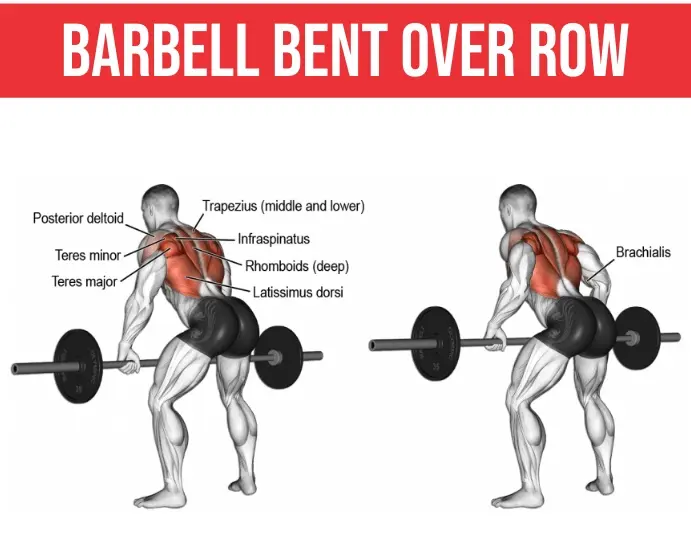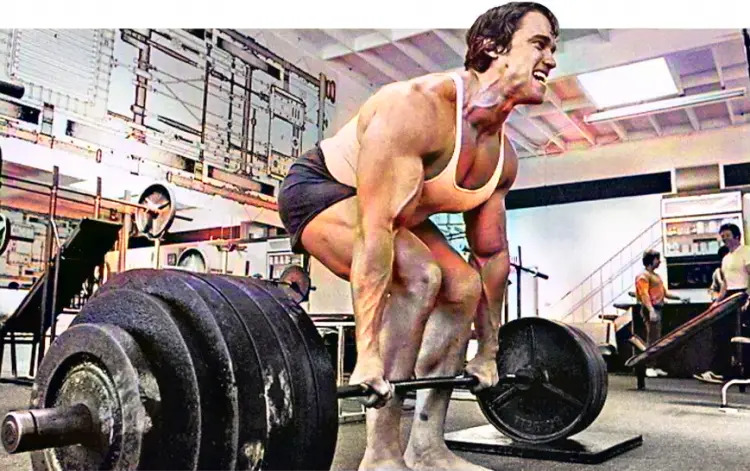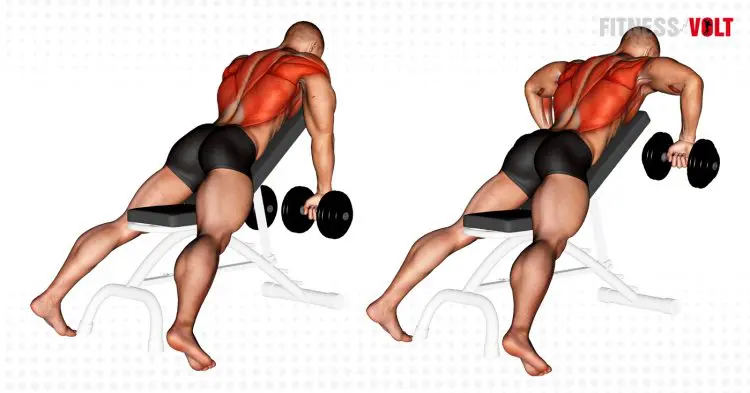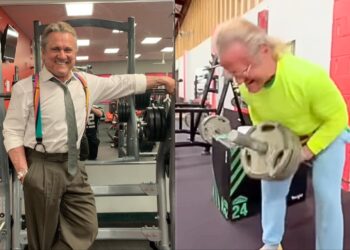Bent-over barbell rows are a popular back exercise. Some of the best bodybuilders have used them to build backs that look like mountain ranges. But, bent-over rows have a downside, too, and they put a lot of pressure on your lower back. While some people can do bent-over rows safely, they’re an injury waiting to happen for others.
The problem with barbell bent-over rows is that there is a tendency to do them with a rounded back. This puts a tremendous amount of stress on the spinous ligaments and intervertebral discs.
These structures are avascular, which means they have a very poor blood supply. Avascular tissue takes a long time to heal and sometimes doesn’t heal at all. That’s why back injuries are often severe and are always best avoided.
The most obvious way to avoid problems with bent-over rows is to do them without rounding your lower back, but that’s easier said than done. Tight hamstrings, a weak core, using too much weight, and lack of postural awareness all mean that some exercisers cannot help looking like a hunchback when they do bent-over rows – even people who should know better!
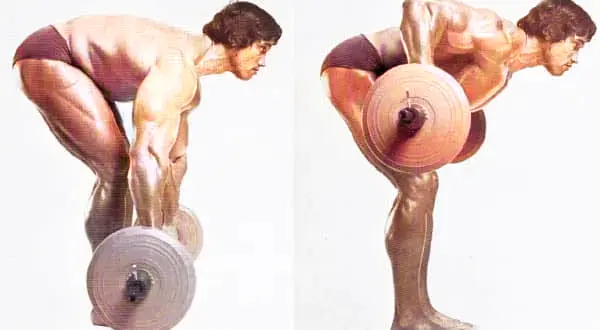
That’s not to say that barbell bent-over rows are a terrible exercise – they’re clearly effective. However, when deciding what movements to include in your bodybuilding workouts, you should always consider the cost versus the benefits. With bent-over rows, the risk of injury may outweigh the rewards.
Level Up Your Fitness: Join our 💪 strong community in Fitness Volt Newsletter. Get daily inspiration, expert-backed workouts, nutrition tips, the latest in strength sports, and the support you need to reach your goals. Subscribe for free!
It’s also important to remember that even exercises as potent as bent-over rows can lose some of their benefits if you do them too often, so that’s another reason for using different movements from time to time.
In this article, we reveal the 12 best bent over row alternatives so you can build the back of your dreams without destroying your spine and keeping your workouts challenging and effective.
Bent Over Row Muscle Worked
Bent-over rows are a compound back exercise. Compound exercises involve multiple joints and muscles working together. So, while most people do bent-over rows for their back muscles, there are several other muscles working too.
The main muscles involved in barbell bent-over rows are:
Latissimus dorsi – known as the lats for short, this muscle is the primary agonist or prime mover during bent-over rows. In other words, it’s the reason most people do this exercise. The lats are located on the sides of your upper back, and their functions are adduction, extension, and medial rotation of the shoulder joint. Well-develop lats look like wings and contribute to a V-shaped torso.
Middle trapezius and rhomboids – located across and between the scapulae, the mid-traps and rhomboids work together to retract your shoulder blades. Developing these muscles will give your upper back thickness and could improve your posture.
Posterior deltoids – while barbell bent-over rows are most definitely a back exercise, your shoulders are also involved. Of the three deltoids, the posterior or rear head is most active during this exercise. Using a wide grip and pulling the bar into your chest increases posterior delt activation.
Biceps brachii – bent over rows give your biceps a good workout alongside your back muscles. Biceps activation is significantly higher if you use a narrow supinated (underhand) grip for this exercise.
Erector spinae – leaning forward to do bent-over rows means that your lower back gets a good workout as you train your upper back muscles. The erector spinae are the muscles that run up your spine. During bent-over rows, these muscles contract isometrically or statically to hold your upper body in position. Weak erector spinae muscles are one of the causes of a rounded back.
Core – this is the collective term for the muscles of your midsection, including your rectus abdominus, obliques, and transverse abdominis. Acting like a weightlifting belt, these muscles contract to create intra-abdominal pressure and support your spine from within.
Glutes and hamstrings – while barbell bent-over rows are an upper body exercise, your legs get in on the action too. Working with your erector spinae, your glutes and hamstrings must work to hold you in that all-important bent-over row position.
17 Best Bent-Over Row Alternatives
Whether bent-over rows bother your back, or you are just looking for some different ways to work your lats, we’ve got the alternatives you need!
Bent-over rows are a horizontal pulling exercise, and while you COULD do things like pull-ups and pulldowns instead, those are vertical pulling exercises, so they aren’t the best alternatives.
So, in this article, we will focus entirely on horizontal pulls as they are the best substitutes for barbell bent-over rows.
1. T-Bar Row
The T-Bar row allows you to row a bar connected to the floor. This reduces the stress on the lower back slightly because not as much balance and stability are required. Just be sure not to overload the bar with a weight that’s too heavy for you.
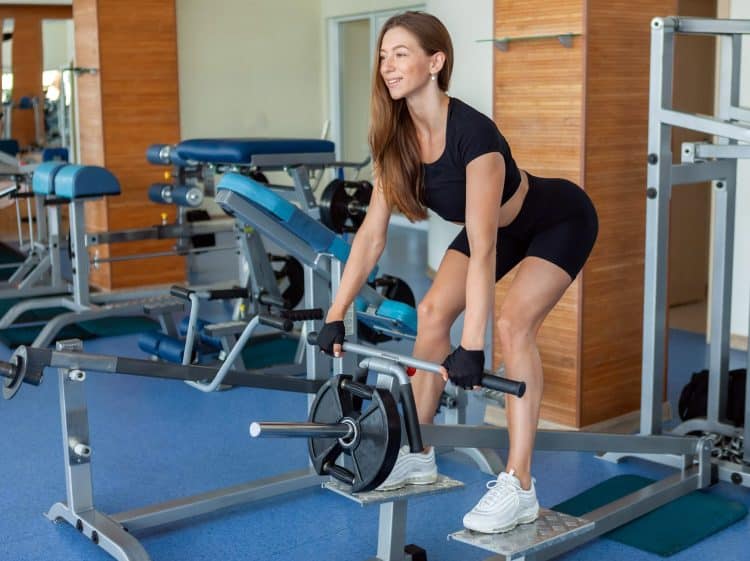
How to do it:
- Load the plates onto the end of the T-Bar row bar.
- Straddle the bar and grab the handles with a neutral grip. In this start position, your torso should be at a 45-degree angle.
- With your back in a neutral, slightly arched position and your entire core tight, pull the bar from a position of full arm extension up to your sternum.
- Lower under control to the start position.
Pro tip: Using 25-pound plates will allow you to bring the bar higher than using 45-pound plates.
Benefits of the T-bar row:
- Awesome lat stretch and contraction
- Potential to go heavy
In This Exercise:
- Target Muscle Group: Latissimus dorsi
- Secondary Muscles: Trapezius, rhomboids, rear deltoids, biceps
- Type: Hypertrophy
- Mechanics: Isolation
- Equipment: Machine or barbell
- Difficulty: Advanced
- Best Rep Range:
- Hypertrophy: 8-15
- Strength: 1-5
Check out the in-depth T-Bar row guide here!
2. Single-Arm Dumbbell Row
The single-arm dumbbell row is a lower back-friendly barbell bent-over row alternative. This is also a unilateral movement, where you are training each side of the back by itself. This overcomes the problem of the stronger side taking over, which often happens with barbell exercises.
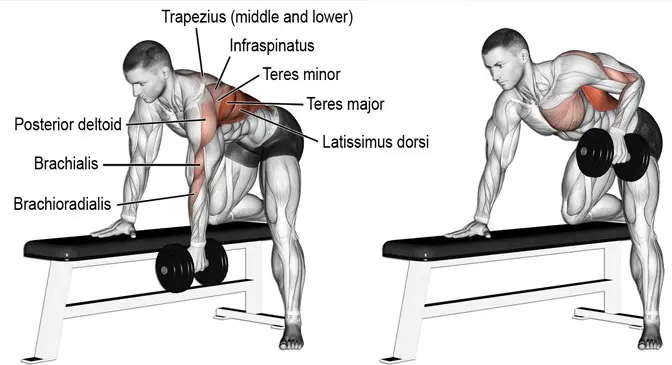
How to do it:
- Place a dumbbell alongside a flat bench.
- Stand on the same side of the bench as the dumbbell and place your closest knee on it. Use the same hand to support your body. Use the same hand to support your body.
- Reach down to grab the dumbbell with the outside hand with an overhand grip.
- From a starting position with the dumbbell hanging at full arm extension, and keeping your core tight, pull the dumbbell up to the level of your hip.
- Lower under control.
Pro tip: Keep your hip down to avoid using momentum to get the weight up. Use a range of reps from a high of 20 down to a low of six.
Benefits of the single-arm dumbbell row:
- Works each side individually
- Lower back-friendly
In This Exercise:
- Target Muscle Group: Latissimus dorsi
- Secondary Muscles: Trapezius, rhomboids, rear deltoids, biceps
- Type: Hypertrophy
- Mechanics: Isolation
- Equipment: Dumbbell
- Difficulty: Beginner
- Best Rep Range:
- Hypertrophy: 8-15
- Strength: 1-5
Check out the in-depth dumbbell row guide here!
3. Kroc Rows
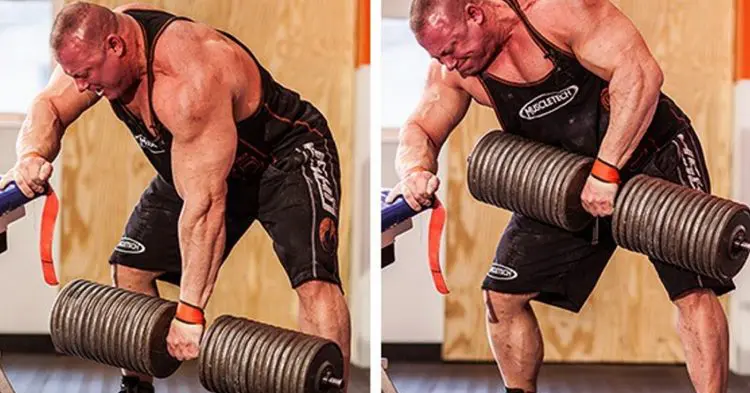
Kroc rows are a variation of single-arm dumbbell rows. Named after bodybuilder and powerlifter Mathew Kroczaleski, who after gender reassignment is now called Janae Marie Kroc, this exercise involves lifting heavy weights for high reps to build both muscle size and strength. If you want to kick your single-arm row workouts up a notch, this could be the exercise for you.
Learn all about Kroc rows in our in-depth article.
4. Body Rows

You don’t need a whole lot of equipment to work your upper back. In fact, body rows, also known as inverted rows and Australian rows, use your body weight for resistance, and you can do them anywhere you can find a waist-high bar. They work all of the same muscles as bent-over rows but put very little stress on your lower back.
Check out our guide and learn how to do this effective bodyweight exercise.
5. Inverted Row
The inverted row is a bodyweight exercise that sees you working against gravity to pull your body up to a bar. It’s the same movement as a barbell row but in reverse. This exercise is great for people to build up the strength to be able to do weighted rowing exercises. This is a very back-friendly version of the row.
How to do it:
- Position a bar about three feet above the floor. If available, you can use a Smith machine to easily set the bar position.
- Lie on the floor with your chest under the bar.
- Reach up to grab the bar with a slightly wider than shoulder-width overhand grip. Your body should now be angled at about 30 degrees, with your heels on the floor.
- From a dead hang position, pull your body up toward the bar until you achieve a full contraction (your chest should touch the bar).
- Lower under control to the start position.
Pro tip: Don’t let your elbows flare out; keep them at a 45-degree angle. To make the exercise easier, put the bar higher.
Benefits of the inverted row:
- Doesn’t require equipment
- Can be progressed to build up to weight resistance versions
In This Exercise:
- Target Muscle Group: Latissimus dorsi
- Secondary Muscles: Trapezius, rhomboids, rear deltoids
- Type: Hypertrophy
- Mechanics: Isolation
- Equipment: None
- Difficulty: Beginner
- Best Rep Range:
- Hypertrophy: 8-15
Check out the in-depth inverted row guide here!
6. Pendlay Rows
Pendlay rows are very similar to bent-over rows, but they’re a little easier on your lower back. With Pendlay rows, you set the bar down on the floor between reps, giving your back and grip a brief rest. Named after US weightlifting and powerlifting coach Glen Pendlay, this is an excellent exercise for building strength and muscle size.
Discover how to do Pendlay rows here.
7. Deadlifts
Deadlifts might not look a lot like bent-over rows, but they work almost all of the same muscles. When you do deadlifts, you have to push the barbell back toward your legs, activating your lats. You also need to pull your shoulders down and back, working your traps and rhomboids. Many bodybuilders include deadlifts in their back workouts.
Level Up Your Fitness: Join our 💪 strong community in Fitness Volt Newsletter. Get daily inspiration, expert-backed workouts, nutrition tips, the latest in strength sports, and the support you need to reach your goals. Subscribe for free!
Learn how to deadlift the right way in this detailed guide.
8. Rack Pulls

Rack pulls are a deadlift variation where you lift the bar from the pins of a power rack. This reduces the range of motion, allowing you to lift more weight. Starting with the bar off the floor means less low back stress and not so much lower body work. However, like deadlifts, it’s still an effective upper back builder.
Check out our guide to rack pulls here.
9. Seated Cable Row
The seated cable row allows for the same range of motion as the bent-over row but without the lower back strain. You are in a more natural, seated position, allowing for more target focus on the lats and mid-traps.
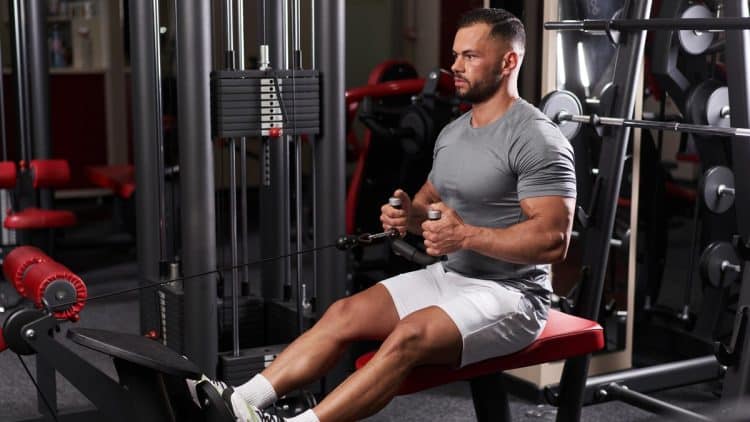
How to do it:
- Sit on a cable machine with your knees slightly bent and grab the handles.
- Your arms should be extended, and lats flared in the starting position. Maintain a neutral spine and a tight core.
- Row the handle into your belly button. Do not lean back as you pull. Squeeze your shoulder blades together in the contracted position.
- Lower to the full stretch position under control.
Pro tip: Do not round your back at any time during this exercise. Don’t use a weight that is so heavy that you can’t get a full range of motion. Control the weight all the way on the return.
Benefits of the seated cable row:
- Provides great lat contraction and extension
- More biceps emphasis than most rowing exercises
In This Exercise:
- Target Muscle Group: Latissimus dorsi
- Secondary Muscles: Trapezius, rhomboids, rear deltoids, biceps
- Type: Hypertrophy
- Mechanics: Isolation
- Equipment: Machine
- Difficulty: Intermediate
- Best Rep Range:
- Hypertrophy: 8-15
- Strength: 1-5
Check out the in-depth seated cable row guide here!
10. Incline Dumbbell Row
The incline dumbbell row is the most lower back-friendly bent-over row alternative. That’s because you’re lying prone on an incline bench, which takes the lower back out of the movement.
How to do it:
- Place a pair of dumbbells at the head of an incline bench. Set the bench angle to 45 degrees.
- Lie face down on the bench and extend your arms toward the dumbbells. Plant your feet on the floor and push your lower back into the bench.
- Grab the dumbbells with a neutral grip so that your palms are facing each other.
- Depress your shoulders and flare out your lats as you pull the dumbbells up to the bench. In the top position, your elbows should be behind your torso.
- Pause and squeeze your shoulder blades together at this position.
- Lower under control.
Pro tip: Pause for a second in the top contracted position as you squeeze the scapula together.
Benefits of incline dumbbell row:
- Lower back-friendly
- Eliminates momentum
In This Exercise:
- Target Muscle Group: Latissimus dorsi
- Secondary Muscles: Trapezius, rhomboids, rear deltoids
- Type: Hypertrophy
- Mechanics: Isolation
- Equipment: Dumbbells
- Difficulty: Intermediate
- Best Rep Range:
- Hypertrophy: 8-15
- Strength: 1-5
Check out the in-depth incline dumbbell row guide here!
11. Seal Row
The seal row is done on a modified bench that is taller than the conventional flat bench. This allows you to get a full lat stretch from a horizontal row while lying on a flat bench. Some gyms also have specially angled bars that will enable you to pull your elbows past your torso.
How to do it:
- Place a loaded bar under a seal row bench.
- Lie face down on the bench with your arms perpendicular to the floor.
- Grab the bar with a shoulder-width overhand grip.
- Depress your shoulders as you pull the bar up to the bench, keeping your core tight and pressed against the bench padding.
- Lower under control.
Pro tip: If you don’t have access to a seal row bench, you can improvise by putting some 45-pound plates under the legs of a standard bench. This will elevate it so that you are able to get a decent lat stretch. Just be sure that the bench is even and stable before you get on it.
Benefits of the seal row:
- Lower back-friendly
- Full range of motion
- Reduces momentum
In This Exercise:
- Target Muscle Group: Latissimus dorsi
- Secondary Muscles: Trapezius, rhomboids, rear deltoids
- Type: Hypertrophy
- Mechanics: Isolation
- Equipment: Barbell
- Difficulty: Intermediate
- Best Rep Range:
- Hypertrophy: 8-15
- Strength: 1-5
Check out the in-depth seal row guide here!
12. Lawnmower Rows
Lawnmower rows are so-called because, when you do them, it looks like you are pulling on the starter handle of a gas-powered lawnmower. Using a low cable machine, this exercise workouts your upper back and biceps, as well as your core, especially your obliques.
How to do it:
- Attach a D-shaped handle to a low cable machine.
- Hold the handle and step back into a staggered stance for stability. Brace your abs and pull your shoulders down and back.
- From this position, bend your arm and pull the cable up and back to your ribs, leading with your elbow. Rotate your torso slightly to increase your range of motion.
- Lower the weight back to the starting position and repeat.
- Do the same number of reps on both sides.
13. Renegade Row
The renegade row is a unilateral rowing exercise done from a top plank position. This makes it much easier on the lower back than the standing bent-over row. Working each side of the back individually also prevents the stronger side from taking over.
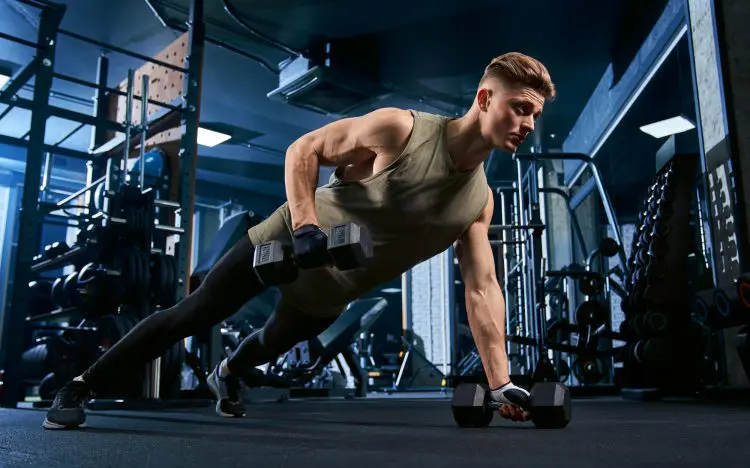
How to do it:
- Grab a pair of dumbbells and get down on the floor in the top plank position. The points of contact with the floor would be the two dumbbells sitting directly under your shoulders and toes.
- Spread your feet shoulder-width apart to provide a good support base.
- Keeping your core tight and butt down, row one dumbbell up to the side of your chest.
- Lower and repeat with the other dumbbell.
Pro tip: To get a great lat pump, superset the renegade row with pull-ups. The combination of horizontal and vertical rowing will develop both width and thickness.
Benefits of the renegade row:
- Works each side of the back individually
- Lower back-friendly
In This Exercise:
- Target Muscle Group: Latissimus dorsi
- Secondary Muscles: Trapezius, rhomboids, rear deltoids
- Type: Hypertrophy
- Mechanics: Isolation
- Equipment: Dumbbells
- Difficulty: Intermediate
- Best Rep Range:
- Hypertrophy: 8-15
- Strength: 1-5
Check out the in-depth renegade row guide here!
14. Yates Row
Dorian Yates, a six-time Mr. Olympia winner, had one of the best backs in bodybuilding history. He did bent-over rows but didn’t lean over as far as many of his contemporaries. This allowed him to lift more weight and also reduce the stress on his lower back. Looking at Yates’ physique, it’s clear that this is a potent exercise. Try it; you might like it!
Learn all about the famous Yates row in this article.
15. TRX Row
The TRX row is similar to the inverted row in that it has you pull your body against gravity. It also recruits the body’s stabilizer muscles to keep the body stable and secure. The exercise can be done on any suspension exercise system.
How to do it:
- Secure the TRX band to an overhead anchor point. Stand under the anchor point and grab the TRX handles.
- Lean back until your arms are fully extended. Your body should be at a 45-degree angle to the floor in this position.
- Keep your core, glutes, and hamstrings tight, and pull your body up to the handles until your chest makes contact.
- Lower under control.
Pro tip: To make the exercise more challenging, extend the length of the straps so that your body is closer to the floor.
Benefits of the TRX row:
- Recruits stabilizer muscles
- Works the core
In This Exercise:
- Target Muscle Group: Latissimus dorsi
- Secondary Muscles: Trapezius, rhomboids, rear deltoids, biceps, core
- Type: Hypertrophy
- Mechanics: Isolation
- Equipment: Suspension trainer
- Difficulty: Intermediate
- Best Rep Range:
- Hypertrophy: 8-15
16. Resistance Band Seated Row
The resistance band seated row uses an inexpensive loop resistance band to simulate a seated cable row. With a band, the exercise gets harder as you pull, providing the most intense effect at full contraction.
How to do it:
- Sit on the floor with your legs outstretched, feet together, and a resistance loop band around your midfoot level. Grab the other end of the band in both hands at shoulder width.
- Keep your back upright and your lower back neutral, and pull your arms toward your ribcage.
- Return to the start position.
Pro tip: This exercise can also be done with the band anchored in a doorway. It allows you to move further away from the end of the band and achieve a greater range of motion. The further you are away from the anchor point, the greater the resistance will also be.
Benefits of the resistance band seated row:
- Provides an intense contraction
- Low-cost equipment
In This Exercise:
- Target Muscle Group: Latissimus dorsi
- Secondary Muscles: Trapezius, rhomboids, rear deltoids, biceps
- Type: Hypertrophy
- Mechanics: Isolation
- Equipment: Resistance band
- Difficulty: Beginner
- Best Rep Range:
- Hypertrophy: 8-15
17. Half-Kneeling High-Band Row
The half-kneeling high-band row does a great job of moving the lats through its full range of natural movement, from the fully extended arm position down and toward the hip. It’s also a unilateral move, allowing you to target each lat muscle separately.
How to do it:
- Securely attach a resistance band to an overhead anchor.
- Grab the end of the band in your right hand and kneel on your left knee about six feet back from the anchor point.
- Adjust your position so the band is taut when your arm is at full stretch.
- Pull the band down and in to touch your right hip.
- Return to the start position under control.
- Do the same number of reps on each arm.
Pro tip: Focus on the stretch and contraction in the lats. Hold the fully contracted bottom position as you squeeze the lats.
Benefits of the half kneeling high band row:
- Provides a great stretch for the lats
- Works each side of the back individually
In This Exercise:
- Target Muscle Group: Latissimus dorsi
- Secondary Muscles: Trapezius, rhomboids, rear deltoids
- Type: Hypertrophy
- Mechanics: Isolation
- Equipment: Resistance band
- Difficulty: Beginner
- Best Rep Range:
- Hypertrophy: 8-15
Frequently Asked Questions
What is the best grip for bent-over rows?
The best grip to work the lats and mid traps is an overhand grip, just wider than shoulder width. If you want more bicep engagement, you should use an underhand grip with your palms facing up.
What is the safest bent-over row alternative?
The safest bent-over row alternative is the incline dumbbell row. This version provides the best lower back support while also allowing for a horizontal row through the full range of motion.
Does the bent-over row work the lats as good as the pull-up?
The bent-over row works the lats differently from the pull-up. Rowing involves horizontal pulling to bring the elbows back. In contrast, the pull-up involves vertical pulling where the elbows are pointing straight down. Horizontal pulling is best for lat thickness, while vertical pulling better promotes lat width. For the best overall lat development, you should do both exercises.
Do bent-over rows build biceps?
The bent-over row will engage the biceps as a secondary mover. But they will not be engaged enough to promote significant development. You can increase biceps involvement on the bent-over row by using an underhand grip and bringing your hands closer together.
How often should I do rowing exercises?
Rowing exercises should be done as part of every back workout. To optimally stimulate your back muscles for strength and muscle gains while also allowing for full recovery between workouts, you should train your back every 3-4 days or twice per week.
More Alternative Exercises:
- Reverse Pec Deck Alternatives
- Pec Deck Alternatives
- Face Pull Alternatives
- Back Extension Alternatives
- Inverted Row Alternatives
- Bent Over Row Alternatives
- Seated Cable Row Alternative Exercises
- Lat Pulldown Alternative Exercises
- T-Bar Row Alternative
Wrapping Up
When it comes to bodybuilding exercises, many people are quick to ask questions like “what is the best back exercise” or “what is the best chest exercise.” And while some exercises are undoubtedly better than others, there usually isn’t a single answer that everyone can agree on. That’s because what works for one person may not work for another.
Bent over rows are a classic example of this. For some, they’re one of the best back builders around. For others, they are simply a source of back pain and injury.
Don’t feel that you are missing out because you can’t do a so-called best exercise. While it might be effective, that doesn’t mean it’s right for you.
Listen to your body and experiment with a range of exercises to find your own list of best movements. The exercises that provide the greatest results with the least amount of risk are the ones you should use.
Try these 12 bent-over alternatives to discover the best exercises for building the back of your dreams while minimizing your risk of injury.
Interested in measuring your progress? Check out our strength standards for Face Pull, Pendlay Row, Rack Pull, and more.

